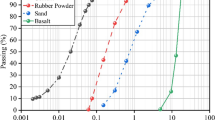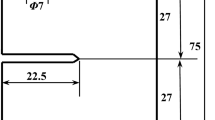Abstract
Fracture behavior is one of the most important, yet still little understood properties of ultra-high performance cementitious composites (UHPCC), a new marine structural engineering material. Research on the fracture and direct tension behavior of UHPCC was carried out. The constitution law of UHPCC was divided into three phases: pre-partial debonding, partial debonding, and pullout phases. A direct tension constitution law was constructed based on the proposed fiber reinforcing parameter as a function of fiber volume fraction, fiber diameter and length, and fiber bonding strength. With the definition of linear crack shape, the energy release rate of UHPCC was derived and the R-curve equation was calculated from this. Loading tests of UHPCC using a three-point bending beam with an initial notch were carried out. The predictions from the proposed R-curve were in good agreement with the test results, indicating that the proposed R-curve accurately describes the fracture resistance of UHPCC. Introduction of a fiber reinforcement parameter bridges the fracture property R-curve and micro-composites’ mechanics parameters together. This has laid the foundation for further research into fracture properties based on micro-mechanics. The proposed tension constitution law and R-curve can be references for future UHPCC fracture evaluation.
Similar content being viewed by others
References
WECHARATANA M, SHAH S P. Slow crack growth in cement composites[J]. Journal of the Structural Division, 1982, 108(6): 1400–1413.
WECHARATANA M, SHAH S P. Predictions of nonlinear fracture process zone in concrete[J]. Journal of Engineering Mechanics, 1983, 109(5): 1231–1246.
ZHANG J, LI V C. Simulation of crack propagation in fiber-reinforced concrete by fracture mechanics[J]. Cement and Concrete Research, 2004, 34(2): 333–339.
MAI Y W. Cohesive zone and crack-resistance(R)-curve of cementitious materials and their fiber-reinforced composites[J]. Engineering Fracture Mechanics, 2002, 69(2): 219–234.
VISALVANICH K, NAAMAN A E. Fracture model for fiber reinforced concrete[J]. ACI Journal, 1983, 80(2): 128–138.
AVESTON J, COOPER A, KELLY A. The properties of fiber composites[C]//Conference proceedings of the National Physical Laboratory. [S.l.]: IPC Science and Technology Press Ltd, 1971.
HANNANT D J, HUGHES D C, KELLY F R S. Toughening of cement and other brittle solids with fibres[J]. Phil Trans R Soc Lond, 1983, 310: 175–190.
NAAMAN A E, NAMUR G, ALWAN J M, NAJM H. Fiber pullout and bond slip I: analytical study, II: experimental validation[J]. ASCE J of Structural Engineering, 1991, 117: 2769–2800.
MORRISON J K, SHAH S P, JENQ Y S. Analysis of fiber debonding and pullout in composites[J]. Journal of Engineering Mechanics, 1988, 114(2): 277–293.
HAN S M, WU X G. Ultimate shear capacity of prestressed girder of ultra high performance fiber reinforced concrete[J]. Journal of the Korea Society of Hazard Mitigation, 2008, 8(2): 51–58.
BARENBLATT G I. The mathematical theory of equilibrium cracks in brittle fracture[C]//Advances in Applied Mechanics. New York: Academic Press, 1962, 55–129.
ANDREWS E H, LEVY G M. Solvent stress crazing in PMMA[J]. Polymer(Surrey), 1974, 15: 599–607.
SCHINKER M G, DOELL W. Interference optical measurements of large deformations at the tip of a running crack in a glossy thermoplastic[C]//Mechanical Properties of Materials at High Rates of Strain Conference Series No. 47. London: Institute of Physics, 1979: 224–232.
GRIFFITH A A. The phenomena of rupture and flow in solids[J]. Philosophical Transactions, 1920, 221: 163–198.
Author information
Authors and Affiliations
Corresponding author
Additional information
Foundation item: Supported by the Center of Concrete Corea, Korea Development and Application of High Performance and Multi-Function Concrete (05-CCT-D11).
WU Xiang-guo is a PhD at Kumoh National Institute of Technology in South Korea and an associate researcher at Harbin Engineering University in China. Research direction is new type structure and material, prestressed structure safety and design.
HAN Sang-mook is a professor at Kumoh National Institute of Technology in South Korea. He is a member of KCI and KSCE. His research interests include high performance cementitious composites and prestressed concrete structure.
Rights and permissions
About this article
Cite this article
Wu, Xg., Han, Sm. Direct tension and fracture resistance curves of ultra high performance marine composite materials. J. Marine. Sci. Appl. 7, 218–225 (2008). https://doi.org/10.1007/s11804-008-8007-7
Received:
Published:
Issue Date:
DOI: https://doi.org/10.1007/s11804-008-8007-7




